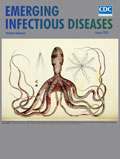
Volume 26, Number 8—August 2020
Research
Evaluating the Effectiveness of Social Distancing Interventions to Delay or Flatten the Epidemic Curve of Coronavirus Disease
Abstract
By April 2, 2020, >1 million persons worldwide were infected with severe acute respiratory syndrome coronavirus 2. We used a mathematical model to investigate the effectiveness of social distancing interventions in a mid-sized city. Interventions reduced contacts of adults >60 years of age, adults 20–59 years of age, and children <19 years of age for 6 weeks. Our results suggest interventions started earlier in the epidemic delay the epidemic curve and interventions started later flatten the epidemic curve. We noted that, while social distancing interventions were in place, most new cases, hospitalizations, and deaths were averted, even with modest reductions in contact among adults. However, when interventions ended, the epidemic rebounded. Our models suggest that social distancing can provide crucial time to increase healthcare capacity but must occur in conjunction with testing and contact tracing of all suspected cases to mitigate virus transmission.
Severe acute respiratory syndrome coronavirus 2 (SARS-CoV-2) emerged in Wuhan, China, in December 2019 (1), and in March 2020, the World Health Organization declared coronavirus disease (COVID-19) a pandemic (2). By April 2, 2020, COVID-19 had spread to >181 countries worldwide, and >1 million confirmed cases of COVID-19 and >50,000 deaths had been reported globally (3).
On January 21, 2020, the first case of COVID-19 in the United States was identified in a traveler who had recently returned to Washington from Wuhan (4,5). By March 14, Washington had reported 642 confirmed cases and 40 deaths associated with COVID-19 (6). In response to the rapid spread of the virus, on March 12, 2020, approximately 7 weeks after the first confirmed case in the state, the governor of Washington announced a set of interventions in 3 counties (7,8). More stringent prohibitions were soon imposed, followed by a shelter-in-place order lasting >6 weeks beginning on March 25, 2020 (9). Similar interventions have been enacted in other US states and in countries in Europe (10,11,12).
We used an epidemic mathematical model to quantify the effectiveness of social distancing interventions in a medium-sized city in the United States or Europe by using Seattle, Washington, as an example. We provide estimates for the proportion of cases, hospitalizations, and deaths averted in the short term and identify key challenges in evaluating the effectiveness of these interventions.






















.png)











No hay comentarios:
Publicar un comentario